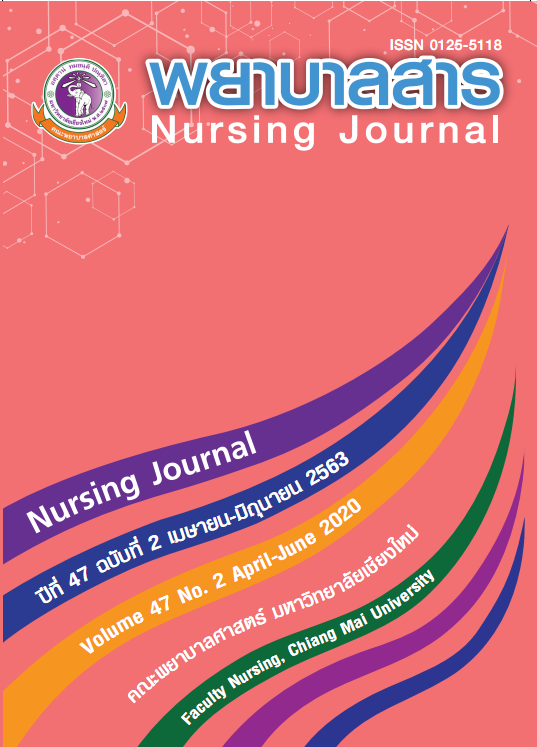Quality Improvement of Nursing Handover, Emergency Room, Uttaradit Hospital
Keywords:
Nursing Handover, Continued Quality Improvement, Uttaradit HospitalAbstract
Nursing handover is important for continuity quality and safety of patient care. The purpose of this study was to improve the quality of nursing handovers in emergency room, Uttaradit Hospital by using the FOCUS-PDCA continuous quality improvement process and SBAR method. The study population was 27 registered nurses. The research instruments were interview guidelines, the nursing handover observation checklist, the nursing handover incident recording form, the nursing handover satisfaction questionnaires, and the interview guidelines for obstacles of nursing handover. All instruments were validated for content by three experts and the inter-rater reliability of two data collectors using the same instruments, the same activity by the consistency of the observation of group handover in every activity was 0.89 and nursing Handover in Emergency Room in every activity was 0.88. Data were analyzed using descriptive statistics and content analysis.
The result showed that after the quality improvement of nursing handover, more than 90.00% of registered nurses can completely and correctly perform with the nursing handover protocol. There were no incidents regarding the nursing handover 45.45% and 36.36% of registered nurses satisfied with nursing handover at high to extremely high levels. The barrier of nursing handover was registered nurse cannot completely perform handover due to taking care of critical ill patients. Nursing administrators can apply this method to improve communication between nurses and doctors as well as nursing handover with other units.
References
Accident and emergency work at Uttaradit Hospital. (2017). Risk report. Uttaradit: Uttaradit Hospital. (In Thai)
Archevarakublook, S. (2004). Practical PDCA: Solving Problems and Improving Work for Success. (2 nd ed.). Bangkok: Xenon Design. (In Thai)
Boonyanurak, B. (1994). Research report on the use of nursing quality assurance program in Develop nursing services in government hospitals. Bangkok: Faculty of Nursing, Chulalongkorn university. (In Thai)
Bureau of Nursing. (2007). Nursing standards in hospitals. Bangkok: Welfare Organization veteran. (In Thai)
Chaboyer, W., Johnson, J., & Wallis, M. (2009). Bedside handover: Quality improvement strategy to “transform care at the bedside. Journal of Nursing Care Quality, 24 (2), 136-142.
Deming, W. E. (1993). The new economics for industry, government, and education. Boston, MA: MIT Press.
Evans, M. E., Pereira, D. A., & Parker, M. G. (2008). Discourses of Anxiety in Nursing Practice: A Psychoanalytic Case Study of the Change-of-Shift handover ritual. Nursing Inquiry, 15 (1), 40-48.
Fernando, K., Adshead, N., Dev, S., & Fernando, A. (2013). Emergency department multiprofessional handover. The clinical teacher, 10, 219–223.
Hansirimichai, J. (2015). The development of the quality of nursing carpooling in nursing units Gynecology, Lampang Hospital (Independent study, Chiangmai University). (In Thai)
Hill, W., & Nyce, M. J. (2010). Human factors in clinical shift handover communication-Review of reliability and resilience principles applied to change of shift report. Cannadian Journal of Respiratiry Therapy, 46 (1), 44-45.
Jenerette, C., & Brewer, C. (2011). Situation, Background, Assessment, and Recommendation (SBAR) May Benefit Individuals Who Frequent Emergency Department s: Adults With Sickle Cell Disease. Journal of Emergency Nursing, 37, 559-561. doi:10.1016/j.jen.2011.02.012
Kelly, P. (2012). Nursing leadership & management. USA: Cengage Learning.
Khamchaikluek, S. Thangcharoenkul, P., & Suphamani, T. (2016). Test Quality Improvement Nursing records in Tertiary Hospital. Nursing Substitute, 43 (4), 105-113. (In Thai)
Laws, D. (2010). Incorporating bedside reporting into change-o f-shift report. Rehabilitation Nursing, 35, 70–74.
Manser, T., & Foster, S. (2011). Effective handover communication: An overview of research and improvement efforts. Best Practice & Research Clinical Anaesthesiology, 25(2), 181-191. doi:10.1016/j.bpa.2011.02.006
McLaughlin, C., & Kaluzny, A. (1999). Continuous Quality Improvement in Health Care. LLC: Jones & Bartlett Learning.
O’Connell, B., Macdonald, K., & Kelly, C. (2008). Nursing handover: It’s time for a change. Contemporary Nurse, 30(1), 2-11. doi:10.5172/conu.673.30.1.2
Randmaa, M., Martensson, G., Swenne, C. L ., & Engstr?m, M. ( 2016). SBAR improves communication and safety climate and decreases incident reports due to communication errors in an anaesthetic clinic: a prospective intervention study. BMJ Open, 4 (1). doi:10.1136/bmjopen-2013-004268
Singthongwan, K. (2015). The development of the quality of nursing handover in nursing u nits Internal Medicine, Prasart Chiang Mai Hospital (Independent Study, Chiangmai University). (In Thai)
Street, M., Eustace, P., Livingston, P. M., Craike, M. J., Kent, B., & Patterson, D. (2011). Communication at the bedside to enhance patient care: A survey of nurses’ experience and perspective of handover. International Journal of Nursing Practice, 17, 133–140.
Suphachuthikun, A., & Srirattanaball, J. (2000). Quality of health system. Bangkok: Design.
Suwansornwan, S. Thangcharoenkul, P., & Chittapakdee, B. (2016) . Quality Improvement Nursing records in Nakornping Hospital Chiang Mai Province. Nursing Section, 43 (3), 128-136.
Uthen, M. (2015). The development of nursing caring quality in surgical wards.Mal e 2, Maharaj Nakorn Chiang Mai Hospital (Independent Study, Chiangmai University). (In Thai).
Uttaradit Hospital Quality Development Center. (2017). Meeting of the Uttaradit Quality Development Team Meeting. Uttaradit: Uttaradit Hospital.
Ye, K., McD, T. D., Knott, J. C., Dent, A., & MacBean, C. E. (2007). Handover in the emergency department: Deficiencies and adverse effects. Emergency Medicine Australasia, 19 (5), 433-441.
Downloads
Published
How to Cite
Issue
Section
License
บทความที่ได้รับการตีพิมพ์เป็นลิขสิทธิ์ของวารสารพยาบาลสาร
ข้อความที่ปรากฏในบทความแต่ละเรื่องในวารสารวิชาการเล่มนี้เป็นความคิดเห็นส่วนตัวของผู้เขียนแต่ละท่านไม่เกี่ยวข้องกับมหาวิทยาลัยเชียงใหม่ และคณาจารย์ท่านอื่นๆในมหาวิทยาลัยฯ แต่อย่างใด ความรับผิดชอบองค์ประกอบทั้งหมดของบทความแต่ละเรื่องเป็นของผู้เขียนแต่ละท่าน หากมีความผิดพลาดใด ๆ ผู้เขียนแต่ละท่านจะรับผิดชอบบทความของตนเองแต่ผู้เดียว






